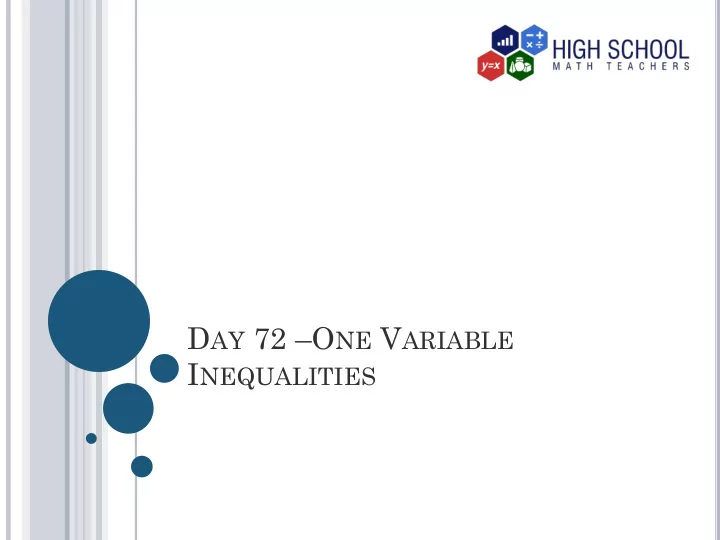

D AY 72 – O NE V ARIABLE I NEQUALITIES
E XAMPLE 1 Solve 2x – 3 < 7 + 3x. Graph the Solution
A NSWER 2 x 3 7 3 x 2 x 3 3 x 7 3 x 3 x Subtract 3x from both sides. 3 7 Combine like terms. x x 3 3 7 3 Add 3 to both sides. x 10 ( 1 )( x ) ( 1 ) 10 Multiply both sides by - 1 and x 10 reverse the inequality symbol.
Graph the solution
E XAMPLE 2 The manager of Family Fare wants to set sandwich prices so that all members of a family of four can each order a sandwich and a drink for less than $20.00. All drinks are priced at $0.89. Write and solve an inequality to find what prices p the manager should set for the sandwiches.
A NSWER The cost for each person is for 1 sandwich and 1 drink, or p + 0.89. For a family of 4, the total cost is 4(p + 0.89). 4 ( p 0 . 89 ) 20 . 00 4 p 3 . 56 20 . 00 Apply the distributi ve property 4 p 3 . 56 3 . 56 20 . 00 3 . 56 Subtract 3.56 from both sides 4 p 16 . 44 4 16 . 44 p Divide both sides by 4. 4 4 4 . 11 p To check, try prices such as $4.25, $4.00, and $3.50. The manager should set all sandwich prices at less than $4.11.
E XAMPLE 3 You can compare an equation and an inequality, such as x = 8 and x < 8, in another way. Recall that adding the same number to both sides of an equation produces an equivalent equation. So does subtracting the same number from both sides and multiplying or dividing both sides by the same number. Find out if these operations produce inequalities that are true.
One solution of the inequality x < 8 is 7, because 7 < 8, as shown on this number line. 6 7 8 9 10 11 12 The number line below shows the result of adding 3 to both sides of the inequality 7 < 8. Because 10 is to the left of 11, you can see that 10 < 11. 6 7 8 9 10 11 12 7 3 8 10 11 true
1. Selecting a different positive and negative integer, you and your partner should each a. add the positive integer to both sides of 7 < 8 b. add the negative integer to both sides of 7 < 8 c. subtract the positive integer from both sides d. subtract the negative integer from both sides
e. multiply both sides of 7 < 8 by the positive integer f. multiply both sides by the negative integer g. divide both sides by the positive integer h. divide both sides by the negative integer
2. Use a number line to help you decide whether each inequality is true or not. Record your results in a table like this. New inequality resulting from True or not true? Partner A Partner B. Adding positive integer Adding negative integer Subtracting positive integer
3. What operations resulted in untrue inequalities? 4. Change the inequality symbol to make each untrue inequality true
5. Substitute a negative solution for x<8 in . Repeat Activities 1 - 2 using this inequality. 6. Substitute a value for x in x > ─ 3 in that results in a true inequality. Repeat Activities 1 - 2.
In the following inequalities, a and b are real numbers, c is a positive real number (c > 0), and d is a negative real number (d < 0). Based on your findings in Activities 1-6, tell whether each statement is true or false.
7.if a < b,then a – c < b – c. a b 8. if a b, then . c c 9.if a < b,then a – d > b – d. 10.if a > b,then ad < bd. 11.if a < b,then ac > bc.
7.if a < b,then a – c < b – c. True a b 8. False if a b, then . c c 9.if a < b,then a – d > b – d. False 10.if a > b,then ad < bd. True 11.if a < b,then ac > bc. False
Replace with the inequality symbol that makes each statement. 12. if x <8,then x + 10 8 + 10. 13. if – x > 2 ,then ( – 1)( – x) ( – 1)(2).
Replace with the inequality symbol that makes each statement. 12. if x <8,then x + 10 < 8 + 10. 13. if – x > 2 ,then ( – 1)( – x) < ( – 1)(2).
14. if x – 6 ≤ – 4,then x – 6 + 6 – 4 + 6. 15. if x+5 < – 1,then x + 5 – 5 – 1 – 5
14. if x – 6 ≤ – 4,then x – 6 + 6 ≤ – 4 + 6. 15. if x+5 < – 1,then x + 5 – 5 < – 1 – 5
3 4 3 4 • • (- if x - 24 ,then x 24 ). 16. 4 3 4 3 2 3 2 3 17. if - x 18 ,then (- ) (- x) (- )( 18 ). 3 2 3 2
3 4 3 4 • • (- ≥ if x - 24 ,then x 24 ). 16. 4 3 4 3 2 3 2 3 17. ≤ if - x 18 ,then (- ) (- x) (- )( 18 ). 3 2 3 2
15 x 30 15 30 if - x < ,then - . 18. - 15 - 15
15 x 30 > 15 30 if - x < ,then - . 18. - 15 - 15
Recommend
More recommend